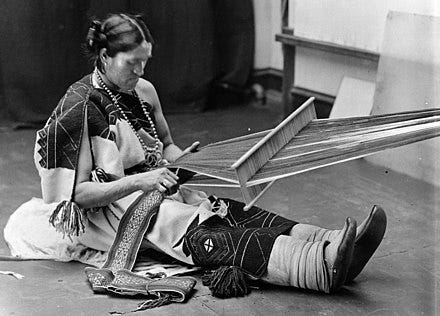My favorite slides from my “Introduction to Gender Diversity” workshop (given to educators, parents, and to anyone who wants to call in allies) feature images of transgender people from throughout history and from different places across the globe.
Meet We’wha a Zuni artisan who lived from 1849-1896. She was sought out in her community for her weaving. We know about her life from a journal kept by a missionary’s wife who claimed We’wha as a friend.
Meet Kumu Hina, a master hula teacher from Honolulu who is Mahu, a gender term that identifies people as being “in the middle” from Hawaiian culture. When Jake was about six he learned that in Hawaii there was a term for a gender that was in the middle. He asked if we could have that in California. I told him we could—a statement that was true in our household, but not true in the world outside our door.
Meet Deborah Sampson who served in the Continental Army from 1782-1783 as a man named Robert Shurtliff. Shurtliff was chosen to join the Light Infantry Troop that traveled with few supplies and took part in small, risky missions. A high fever caused Shurtliff to lose consciousness. A subsequent exam revealed Shurtliff’s intimate body parts. After being honorably discharged Shurtliff lived the remainder of their life as Deborah Sampson and received a pension for soldiers who were injured in combat.
Meet Laxmi Narayan Tripathi who is a bollywood actress and trans rights activist. In 2014 the Supreme Court in India officially recognized transgender people as belonging to a third gender, a victory won in large part to Tripathi’s activism.
Around the world and throughout history, a small percentage of the human population has been born into a gender identity that is not purely male or female. In the mid-twentieth century it was considered “best practice” for western physicians to persuade parents to raise intersex children according to the physician’s best read of their babies’ external genitals (this is where we get the “sex assigned at birth” lingo). This process was far from perfect, and some children received surgeries and were raised in a gender that did not match their true gender identity. Many of these children experienced what we now call “gender dysphoria,” because they had been assigned the wrong gender at birth. This is just one way that the variety of gender was hidden in the twentieth century.
Our culture is awakening from a gender dark age in which gender diversity was eliminated or hidden from view. Trans kids who are brave enough to share their true identity with us are helping us course correct from a medical practice that has caused undue harm to a small, but fabulous population.
*****
If something in this post moved you, if you learned something new, if reading this made you feel more empowered to support the trans community, I hope you’ll consider sharing my free newsletter with a friend! My hope is to double my subscribers this month. Let’s do this!
See you tomorrow! XOXO







